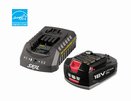
 Even the most seasoned craftsmen can lose sight of the importance of a high-quality power tool battery. As fate would have it, though, a battery is one of the most integral working parts on your cordless power tools. Delivering precise power and energy to your tools, battery technology has been evolving steadily since the introduction of battery powered cordless equipment; whether NiCad, NiMH or Li-Ion technologies, craftsmen should get to know the battery behind their power tools, and essentially behind their products as well.
Even the most seasoned craftsmen can lose sight of the importance of a high-quality power tool battery. As fate would have it, though, a battery is one of the most integral working parts on your cordless power tools. Delivering precise power and energy to your tools, battery technology has been evolving steadily since the introduction of battery powered cordless equipment; whether NiCad, NiMH or Li-Ion technologies, craftsmen should get to know the battery behind their power tools, and essentially behind their products as well.
NICKEL CADMIUM
batteries were the first on the market for cordless power tools and though the technology is older, it is still very reliable. NiCad batteries are less sensitive to adverse temperatures and have a high recharge cycle, meaning they can be charged and recharged repeatedly for a long period of time. NiCad batteries are also less expensive than NiMH and Li-Ion batteries. On the down-side, however, NiCad batteries tend to suffer from battery memory effect. This occurs when a battery can no longer accept a complete charge from the charger because it had been repeated charged without first being fully depleted. It seems the battery “remembers” how much energy it discharged, and only wants to accept back that much energy from charger. The element Cadmium is highly toxic making it the most harmful battery to the environment. Some European vendors, in fact, won’t sell NiCad batteries because their negative environmental impact causes them to be so heavily taxed.
NICKEL METAL HYDRIDE
batteries run on a higher amperage than NiCad batteries, because of this, they also have a longer run-time. NiMH batteries are lighter than NiCad batteries but they are far more sensitive to hot and cold temperatures, in fact, NiMH batteries can’t work in below freezing temperatures (32 degrees Fahrenheit and below) and they degrade very quickly in intensely high temperatures (105 degrees Fahrenheit an up). Although the NiMH battery has a longer run-time than the NiCad battery it doesn’t accept as many charges. NiCad and NiMH batteries do, however, have very similar overall lifespans. NiMH batteries have a larger energy storage capacity than that of the NiCad.
LITHIUM ION BATTERIES
have a higher energy density than most other rechargeable batteries. A high energy density means that the Lithium Ion batteries have a superior energy to weight ratio storing more energy for their size than most other batteries. Li-Ion batteries have a very slow self-discharge rate meaning they retain their charge for much longer. Most rechargeable batteries significantly deplete over periods of unuse, the slow rate of charge-loss in Li-Ion batteries, however, allows them to maintain most of their charge for long periods, even in storage.
 There are many benefits to working with Lithium Ion batteries from their light-weight, to their long run-time. Li-Ion batteries hold their charge for longer periods and they maintain steady power throughout the charge cycle. Other batteries consistently lose power as you work. Li-Ion batteries are light-weight, and have a huge storage capacity, this means you now have a lighter, more efficient and powerful battery without the bulk.
There are many benefits to working with Lithium Ion batteries from their light-weight, to their long run-time. Li-Ion batteries hold their charge for longer periods and they maintain steady power throughout the charge cycle. Other batteries consistently lose power as you work. Li-Ion batteries are light-weight, and have a huge storage capacity, this means you now have a lighter, more efficient and powerful battery without the bulk.
There are, however, some disadvantages to Lithium Ion batteries. Li-Ion batteries are a bit more expensive. The complexities of producing Li-Ion batteries accounts for this price difference. Each Li-Ion battery also requires a specifically built charger to accommodate that type of battery; this means that chargers are more expensive as well, and aren’t universal to all types of Li-Ion batteries. The Li-Ion battery has a built-in chip that protects the battery from over and undercharging, and ensures a longer battery life. This computer chip, however, doesn’t allow the battery to continue accepting charge once that battery’s energy level has dropped below a certain point. Once this happens the battery is essentially dead. Li-Ion batteries also rely on this circuit to stay cool. Since Li-Ion batteries lose charge so slowly, and the battery and charger are so advanced, it’s fairly simple to keep batteries temperate and at a safe charge level.
Lithium Ion batteries are by a landslide the least detrimental to our environment, and for many reasons they are the favorite of most craftsmen.
Keep in mind that the quality of the battery you use is just as important as the quality of your power tool. The battery gives the right amounts of energy and finesse to your tools and their working parts.













